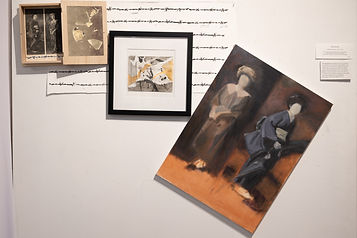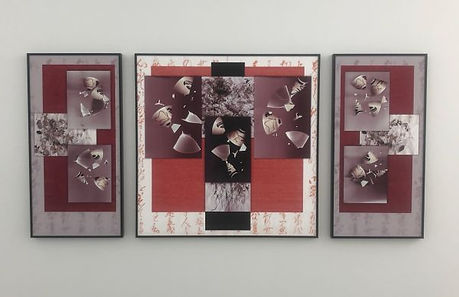The Legacy of Mass Incarceration

Unfinished Business (2016-2021)
This assemblage documents the artist’s process and focus on the intersection of historical, personal and social narratives. The portraits are the artist’s grandmother, who came to the U.S. from Fukui, Japan in the early 1920s. The oil portrait, an early career oil painting from 2016, shows the artist’s new interest in identity work. The abstract work with thread, Crossing to Fukui (center), marks the artist’s shift from representational to non-objective abstraction (2019) and identity work.
Unfinished Business
2016-2021
Mixed media assemblage (inkjet prints on salago paper, wooden hinged box; oil on canvas; watercolor, ink and thread on paper; linocut print on BFK Rives paper)
30 x 50 inches

Trauma (We Endure)
2021 (with collaborator Mei-ling Lee, sound & lighting)
Multimedia interactive installation (ink on card stock tags, linocut print on paper, string, wood, glue, computer-controlled lighting and processed audio)
5in (D) x 5 x 17 feet (VARIABLE)
Trauma (We Endure) (2021)
Following Japan’s attack on Pearl Harbor, the U.S. government incarcerated approximately 120,000 people of Japanese descent, the majority of whom were U.S.-born.
The tags are in the form of the government-issued identification tags worn by families of Japanese descent during forced relocation from their U.S. West Coast homes to concentration camps during World War II. Drawings on these tags were adapted from photographs (public domain) taken by Dorothea Lange and other U.S. War Relocation Authority photographers documenting the transition to and life in 10 camps scattered in remote sites across eight states. As the light appears above a single tag, a voice reading the photo caption as written by the photographer plays out loud. Photo captions also are hand-written on the backs of tags, which viewers are encouraged to flip over.




Grief (We Remember) (2020-2021)
The wall of 240 black tags symbolizes the generational grief suffered by 120,000 individuals of Japanese ancestry subject to forced ethnically-based mass incarceration during World War II. Individual tags are in the form of identification tags worn during relocation from their homes to concentration camps, where residents lived from 1942-1945. Each tag is unique, reflecting individuality within what was incorrectly labeled as a monolithic ethnic and enemy community.
Grief (We Remember)
2020-2021
Installation (ink on card stock tags, museum putty, nails)
59 x 111 inches




Mottainai (Memories) (2021)
The paper “shards” inside this vessel are the torn remnants from the making of the tags in the Grief installation. The shards represent memories that generate and reside in grief. “Mottainai” is a Japanese phrase often translated as “don’t waste.” Within what may seem like a directive is an implied preciousness, gratitude and caring for the object we must not waste.
Mottainai (Memories)
2021
Vessel (flax, thread, ink, paper, birch and paperbark cherry bark, cradled wood panels)
12 x 8 x 8 inches

The Body Remembers (2022)
Represents embodiment of trauma and healing.
The Body Remembers
2022
triptych, digital collage made of original artwork
40 x 92 inches

Broken Promises, Broken Dreams (2021)

Broken Promises, Broken Dreams
2021
Installation. Digital images of scanned objects.
50 x 70 inches

Healing (We Speak) No. 1 & No. 2 (2021)
Healing (We Speak) No. 1 & No. 2
2021
Ink and watercolor on paper
9½ x 13 inches
Time Story | Story Time (Story for My Son) (2023)

Time Story | Story Time (Story for My Son)
2023
Installation/Multiple digital images
5-1/2 x 88 inches